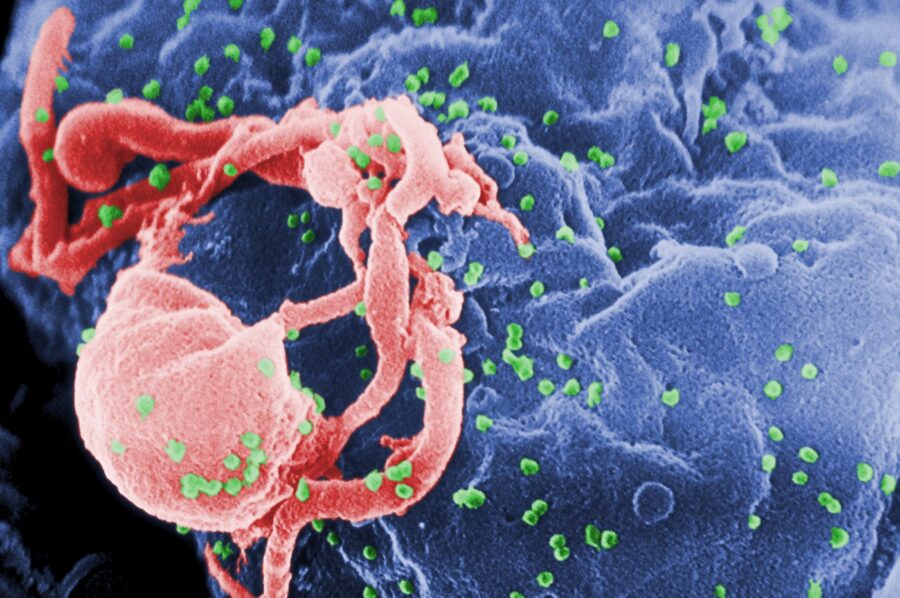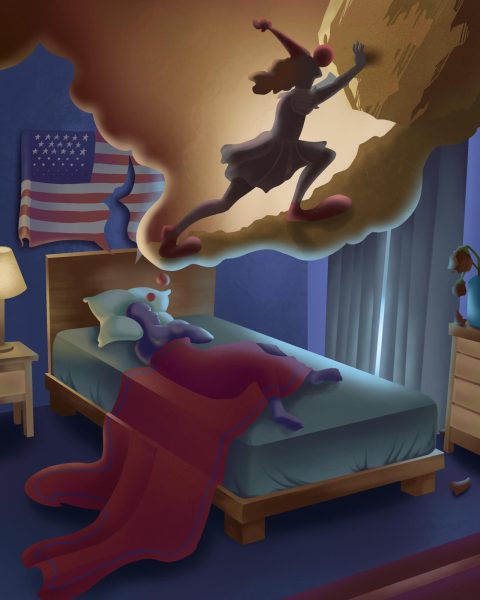Got HIV? There’s a Pill for That
Medical advances change the outlook for AIDS patients
As a gay male in my mid 20s, the idea of catching HIV from a sexual encounter has always been welded to the forefront of my psyche since my late teens. In fact, the idea is so pervasive in my mind that it remained a tangible fear early on in my relationship with my boyfriend. I was once even hesitant to use public restrooms during some of my more ignorant days after hearing the myth of a friend’s cousin supposedly catching the virus after sitting on a public toilet even though he used the disposable toilet seat covers. Needless to say, I now suspect that it wasn’t a dirty toilet seat that the cousin sat on. But I digress.
It was not until almost five years ago, when I met my friend and mentor, James Maupin, 54, and his partner, Roy Kesrouani, 43, that I stopped viewing HIV as a gay man’s life at a dead-end, but in fact, a chance to turn a corner and head off into a new beginning.
According to the website AIDSinfo.gov, the FDA has approved more than 24 different antiretroviral drugs, categorized under five separate classes of HIV drugs. The classes of drugs target one of the three enzymes (reverse transcriptase, integrase, and protease) located at the core of the virus alongside its RNA strands. Ultimately, the goals of these drugs are to improve the overall quality of life of patients with HIV by raising their blood T-cell count and generally strengthening their immune system function while also controlling the growth of the virus, or viral load. The drugs also aid in suppressing symptoms of HIV, such as fever, diarrhea, and swollen lymph nodes. In order to accomplish these feats, doctors usually prescribe a patient with a combination, or “cocktail,” of these drugs in order to target multiple enzymes at once to keep the virus from replicating. The prescription combination of at least two pills is called Highly Active Antiretroviral Therapy HAART.
Just to be clear, even if someone infected with HIV is on HAART drugs, that person can still transmit the virus onto others.
“I take Norvir, Prezista, and Truvada,” said Kesrouani, “They are protease inhibitors that forbid the HIV cell to replicate.” “And, I take Truvada and Nevirapine,” said Maupin.
The cost for a month’s supply of Truvada before co-pay is $3,500 alone. With co-pay, Roy pays $180 a month for his supply of HIV drugs while James pays $90.
The Truvada pill is a combination of two drugs, emtricitabine and tenofovir disoproxil fumarate. For James and Roy, and anyone else who already has HIV, the Truvada pill’s job is to block HIV reverse transcriptase from replicating, resulting in a lower count of HIV in the blood.
Additionally, the website aids.gov states that gay or bisexual men, and heterosexual women who are HIV negative but are at a substantial risk for HIV can take Truvada as a pre-exposure prophylaxis PrEP. In this case, the medication works to prevent the virus from establishing itself as a permanent infection and, when consistently taken, has proven up to 92 percent effective for those who are at high risk.
In terms of those who fear they may have been exposed to the virus, a doctor may prescribe a post-exposure prophylaxis PEP. Essentially, a combination of different types of antiretroviral drugs targeting the protease and reverse transcriptase enzymes of the virus.
In Kesrouani’s case, the Norvir plays the role of the “booster” and is taken alongside the Prezista and Truvada in order to intensify their effect.
For Maupin on the other hand, the Nevirapine and Truvada work together like a drug tag-team in that they both prevent the HIV enzyme reverse transcriptase from replicating itself, however, the Nevirapine must first bond with the enzyme in order to accomplish the same purpose.
Needless to say, the combination of these drugs sends the body into a tailspin of side effects. “The first year, you’re like, ‘This isn’t me.’ You smell different. Everything about you is different,” said Kesrouani. “[The drugs] gave me nausea, and it burned [my] stomach,” he added, “It makes you edgy and I can’t sleep at night. Some can also be hallucinatory.”
Due to some of the painful side effects that Kesrouani must contend with, he obtained a medical marijuana license in order to better cope with the pain, lack of sleep, and lack of appetite.
“The worst symptom of the medication for me is loose bowels,” said Maupin. “For me, that’s my biggest side effect.” Maupin also added that the combination of the pills might also lead to a reduction of testosterone levels. In order to negate this side effect, James uses a testosterone gel called AndroGel that keeps his testosterone at normal levels.
“Fortunately for me, I only have to take three pills per day,” added Maupin, “I know guys who take up to 25 pills per day. My ex-boyfriend had to take pills every 3–4 hours.”
When a person with HIV takes these drug cocktails, they are at higher risk of getting high blood pressure and high cholesterol. One also gains weight significantly as the body, due to the drugs, finds it difficult to utilize and break down fat cells. What’s worse is that the body may even store the fat in concentrated locations such as on the back resulting with what Kesrouani and Maupin call a, “buffalo hump.”
As both Maupin and Kesrouani refuse to let the medications affect their bodies in such a manner that will result with unsightly “buffalo humps” and having to consume pills for diabetes, high blood pressure, and high cholesterol, they’ve chosen to maintain a healthy diet that’s low in fat, sugar, and salts. “Every person with HIV also has to take pills for high blood pressure and diabetes, so you have to be very proactive in order to negate that,” said Kesrouani. “But we don’t have to worry about that,” adds Maupin, “our blood pressures and cholesterol numbers are right where they should be. We want to be on the least amount of pills as possible. That’s why we choose to eat better to maintain a healthier lifestyle.”
Dr. Michael Albertson, a gastroenterologist in the UCLA Division of Digestive Diseases, was working in Los Angeles during the height of the AIDS epidemic in the early 1980s. Sherman Oaks Hospital, where he was on staff, had an entire floor dedicated to AIDS patients.
“We had no effective medication and patients died of opportunistic infections, blood clotting disorders, and Kaposi’s sarcoma.We tried our best to treat these patients, but we had ineffective therapy at the time and could not stop the progression of the disease. Patients died despite our best efforts.” -Michael Albertson MD
But now with the new therapies, Albertson said that patients are living healthy and productive long lives.
“Some of my patients have been on therapy for more than 20 years and are doing fine as long as they take their medication, which is a complicated and expensive regimen,” Albertson said.
Hands down, the most interesting side effect of the HIV drugs was Maupin’s explicit appreciation for his second chance at life.
“If it wasn’t for the medication, we probably would’ve had at least five years left in our lives,” said Maupin. In the case of Kesrouani, who once was at his deathbed at the hands of full-blown AIDS, he walked away from the experience knowing that every moment must be cherished and enjoyed.
Maupin explains his gratitude for the medications as he lovingly stares at Kesrouani, “It allows me to plan ahead because I intend to spend and live a long and productive life with my partner, Roy, and enjoy the things we enjoy. It also allows me to enjoy myself even more and be more ‘in the moment.’”
Kesrouani has come to appreciate having recovered from AIDS and views the world through a different lens in the sense that he now believes that life is incapable of throwing anything his way that should render him miserable. “I appreciate that life is ephemeral and because of its nature and my experience, I’ve managed to see the world now for all its wonders and beauty. In the end, being recognized, accepted by your parents, finding a career is all so trivial. I now try to enjoy the time I have because tomorrow is never promised,” said Kesrouani.
As a recovered AIDS patient, Kesrouani knows full well how dreadful and horrifying life can be when brought to the brink of death at the hand of the virus.
“They put me in a ward where people were dying,” said Kesrouani. “All I heard all day and night was people slowly and agonizingly dying in their final breaths. All the while, my stomach was so messed up that I couldn’t eat for three months.”
Adding insult to injury, Roy felt very discriminated against as his ordeal surviving the virus led him through the doors of three different hospitals. In all of which, he never once saw the face of the doctor who was treating him.
After recovering from his first battle with AIDS, Kesrouani wound up in the hospital again some time after. Due to his confidence spurred on by his recovery, Kesrouani stopped taking his meds while on his first cocktail and went straight to the hospital with pneumonia and into his second fight with AIDS. It’s important to know that if one misses too many doses of their HAART treatment, it allows the virus to build up a resistance to that particular cocktail. Meaning, in order to get back on HAART, that person needs a completely different cocktail from the one he started with. Kesrouani is now on his second cocktail and hasn’t missed a dose since.
In general, one of the downsides of HIV drugs in the gay community, notes Maupin, is their existence is seen as a sort of “ticket” to risky sexual behaviors. “That was me,” said Maupin, “I thought to myself that, at 45, I had another 20 good years left due to the pills. Not to mention there’s a lot of wild-ass tail out there in the world that I wanted to go and conquer.” In short, the drugs were Maupin’s “cop-out.”
Maupin and Kesrouani admit that they harbor no regrets with regards to the actions and lifestyle choices that lead their lives to the point of having HIV. “Hell, if it wasn’t for the damn virus,” Maupin says, “I never would’ve met the love of my life.”
In essence, Maupin and Kesrouani don’t take living with HIV for the rest of their lives lightly. Overall, they’ve greatly appreciated the HAART treatment and how it’s brought their lives closer to normal. The combined life experiences of these two men have taught them to value and not resist the gentle flow of the universe that carries everyone .
Perhaps, then, if one plucks a rose from a bush in order to appreciate its sweet scent, then one must also appreciate the rose’s thorns and not view the pain and the blood drawn from them as ugly but just as beautiful and sweet as the rose itself.
Substance is a publication of the Mt. San Antonio College Journalism Program. The program recently moved its newsroom over to Medium as part of a one-year experiment. Read about it here.











